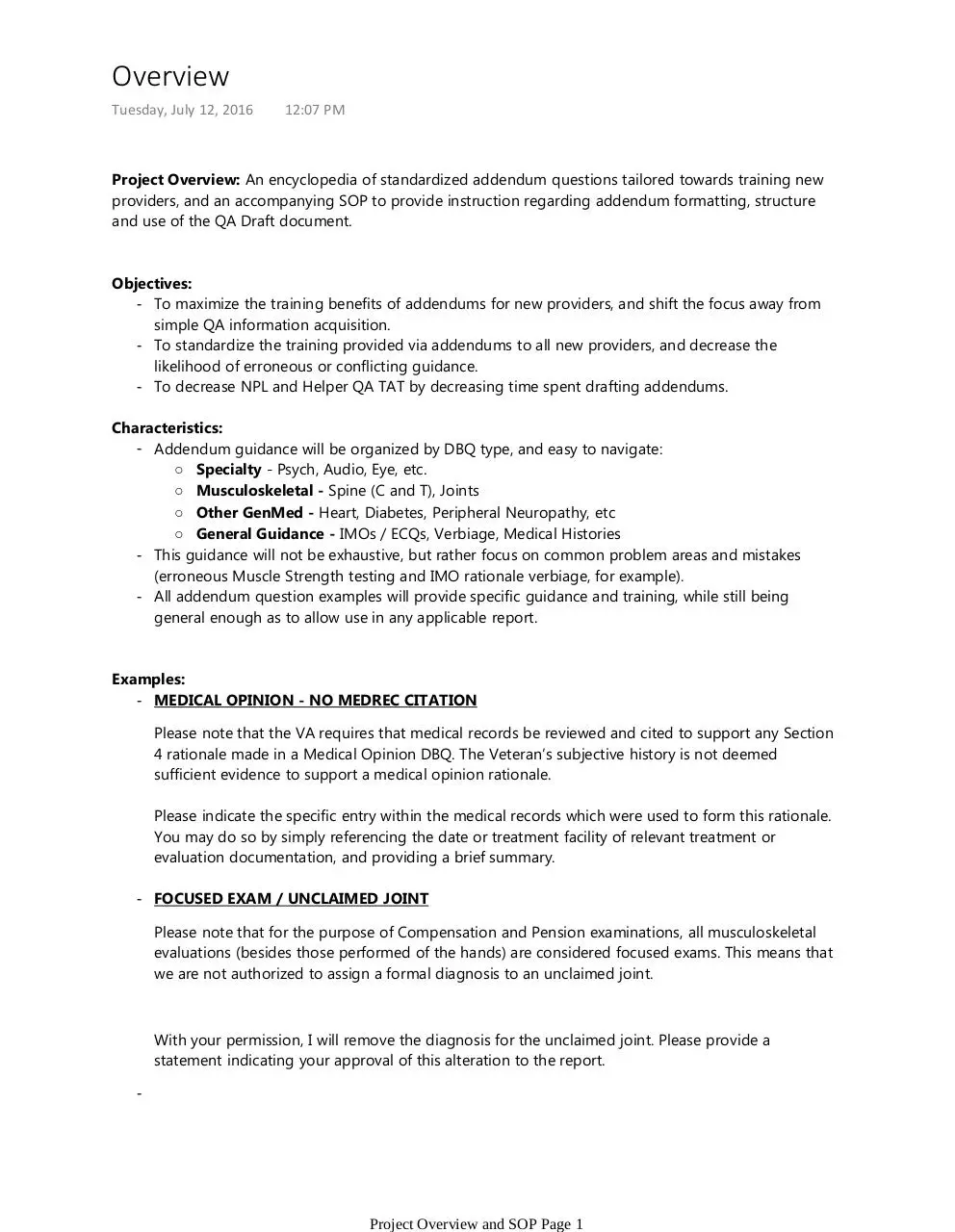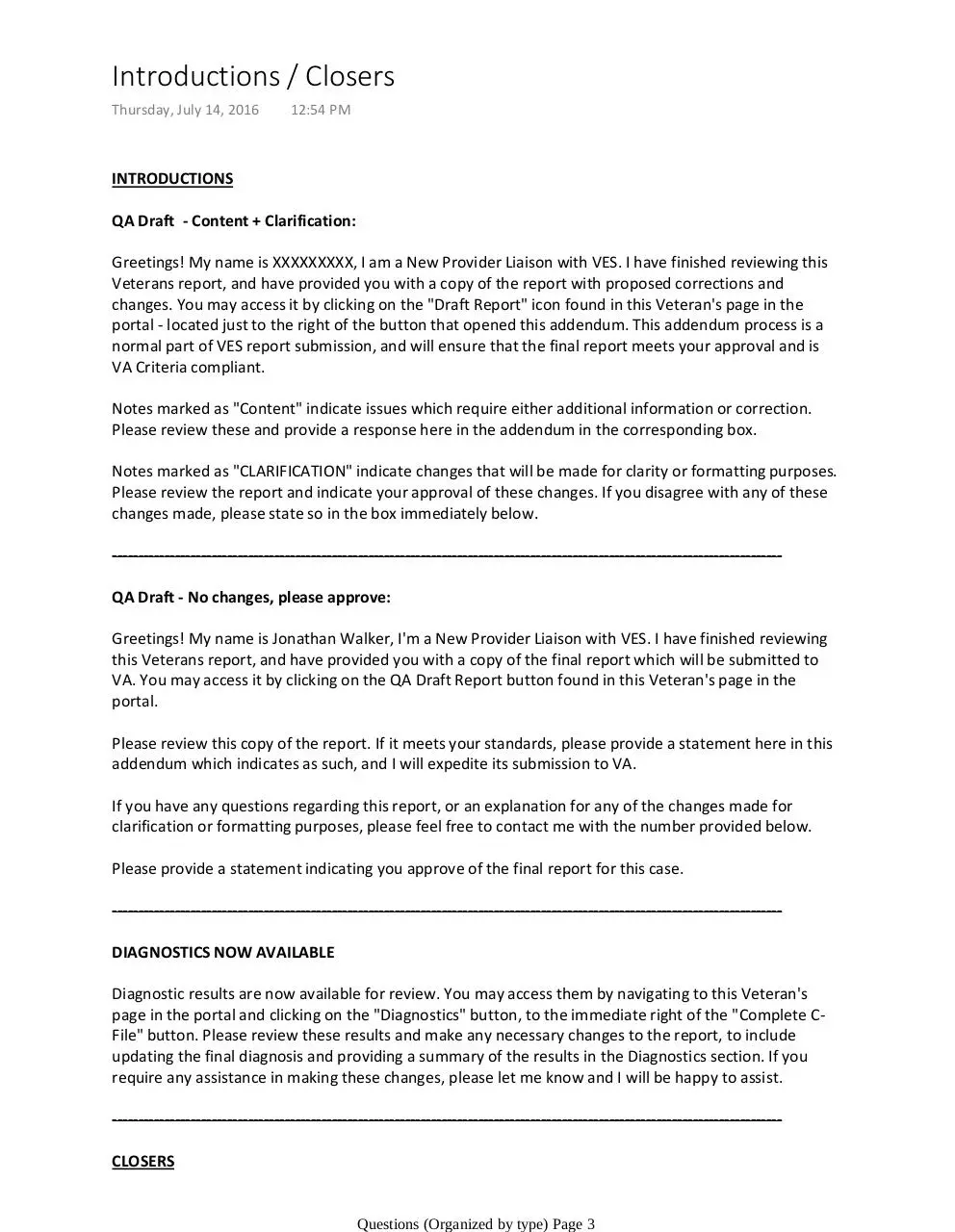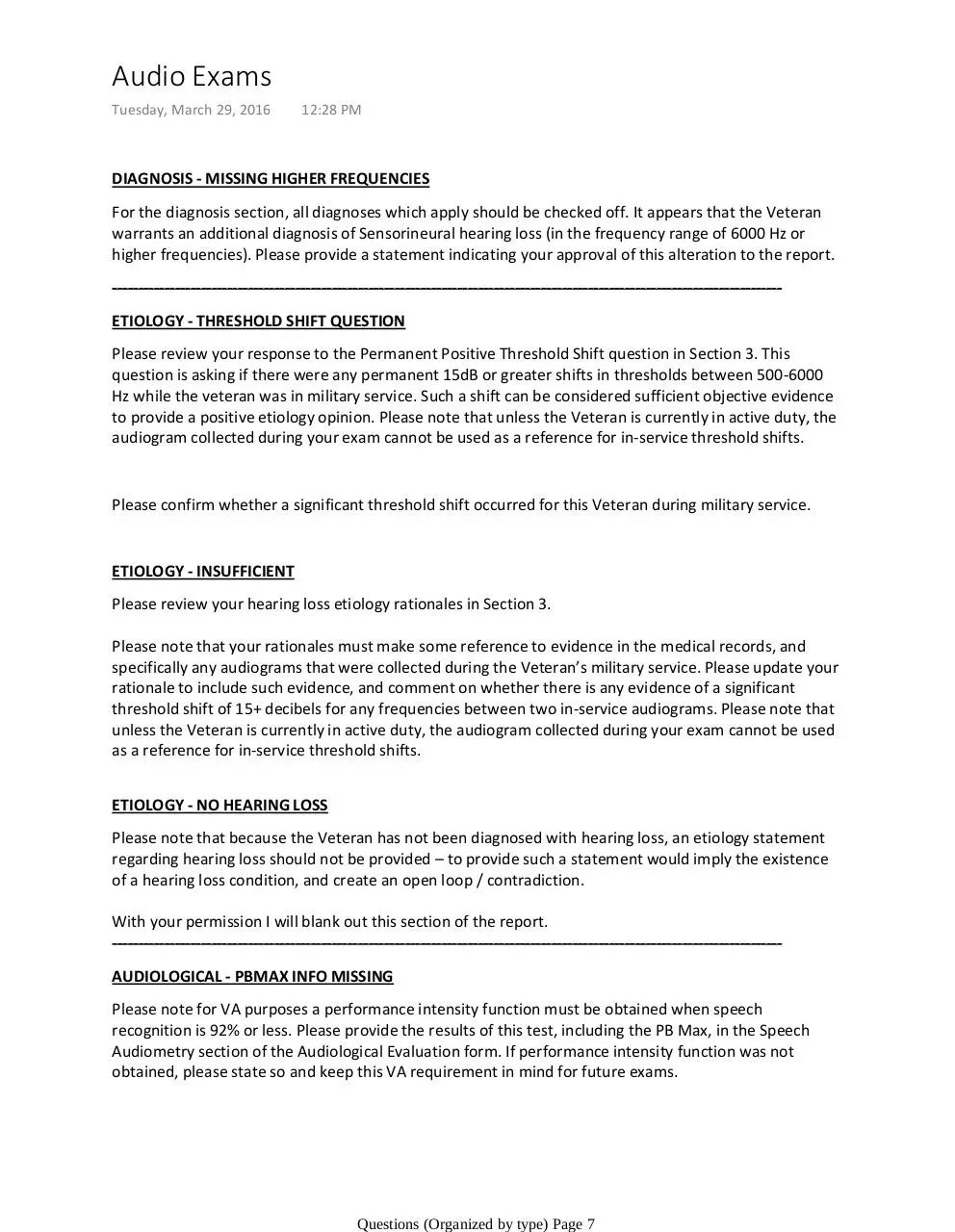Addendum Encyclopedia Project (PDF)
File information
This PDF 1.6 document has been generated by Microsoft® OneNote® 2013, and has been sent on pdf-archive.com on 29/09/2016 at 21:07, from IP address 70.42.x.x.
The current document download page has been viewed 556 times.
File size: 609.15 KB (19 pages).
Privacy: public file





File preview
Overview
Tuesday, July 12, 2016
12:07 PM
Project Overview: An encyclopedia of standardized addendum questions tailored towards training new
providers, and an accompanying SOP to provide instruction regarding addendum formatting, structure
and use of the QA Draft document.
Objectives:
- To maximize the training benefits of addendums for new providers, and shift the focus away from
simple QA information acquisition.
- To standardize the training provided via addendums to all new providers, and decrease the
likelihood of erroneous or conflicting guidance.
- To decrease NPL and Helper QA TAT by decreasing time spent drafting addendums.
Characteristics:
- Addendum guidance will be organized by DBQ type, and easy to navigate:
○ Specialty - Psych, Audio, Eye, etc.
○ Musculoskeletal - Spine (C and T), Joints
○ Other GenMed - Heart, Diabetes, Peripheral Neuropathy, etc
○ General Guidance - IMOs / ECQs, Verbiage, Medical Histories
- This guidance will not be exhaustive, but rather focus on common problem areas and mistakes
(erroneous Muscle Strength testing and IMO rationale verbiage, for example).
- All addendum question examples will provide specific guidance and training, while still being
general enough as to allow use in any applicable report.
Examples:
- MEDICAL OPINION - NO MEDREC CITATION
Please note that the VA requires that medical records be reviewed and cited to support any Section
4 rationale made in a Medical Opinion DBQ. The Veteran’s subjective history is not deemed
sufficient evidence to support a medical opinion rationale.
Please indicate the specific entry within the medical records which were used to form this rationale.
You may do so by simply referencing the date or treatment facility of relevant treatment or
evaluation documentation, and providing a brief summary.
- FOCUSED EXAM / UNCLAIMED JOINT
Please note that for the purpose of Compensation and Pension examinations, all musculoskeletal
evaluations (besides those performed of the hands) are considered focused exams. This means that
we are not authorized to assign a formal diagnosis to an unclaimed joint.
With your permission, I will remove the diagnosis for the unclaimed joint. Please provide a
statement indicating your approval of this alteration to the report.
-
Project Overview and SOP Page 1
Introductions / Closers
Thursday, July 14, 2016
12:54 PM
INTRODUCTIONS
QA Draft - Content + Clarification:
Greetings! My name is XXXXXXXXX, I am a New Provider Liaison with VES. I have finished reviewing this
Veterans report, and have provided you with a copy of the report with proposed corrections and
changes. You may access it by clicking on the "Draft Report" icon found in this Veteran's page in the
portal - located just to the right of the button that opened this addendum. This addendum process is a
normal part of VES report submission, and will ensure that the final report meets your approval and is
VA Criteria compliant.
Notes marked as "Content" indicate issues which require either additional information or correction.
Please review these and provide a response here in the addendum in the corresponding box.
Notes marked as "CLARIFICATION" indicate changes that will be made for clarity or formatting purposes.
Please review the report and indicate your approval of these changes. If you disagree with any of these
changes made, please state so in the box immediately below.
-------------------------------------------------------------------------------------------------------------------------------QA Draft - No changes, please approve:
Greetings! My name is Jonathan Walker, I'm a New Provider Liaison with VES. I have finished reviewing
this Veterans report, and have provided you with a copy of the final report which will be submitted to
VA. You may access it by clicking on the QA Draft Report button found in this Veteran's page in the
portal.
Please review this copy of the report. If it meets your standards, please provide a statement here in this
addendum which indicates as such, and I will expedite its submission to VA.
If you have any questions regarding this report, or an explanation for any of the changes made for
clarification or formatting purposes, please feel free to contact me with the number provided below.
Please provide a statement indicating you approve of the final report for this case.
-------------------------------------------------------------------------------------------------------------------------------DIAGNOSTICS NOW AVAILABLE
Diagnostic results are now available for review. You may access them by navigating to this Veteran's
page in the portal and clicking on the "Diagnostics" button, to the immediate right of the "Complete CFile" button. Please review these results and make any necessary changes to the report, to include
updating the final diagnosis and providing a summary of the results in the Diagnostics section. If you
require any assistance in making these changes, please let me know and I will be happy to assist.
-------------------------------------------------------------------------------------------------------------------------------CLOSERS
Thanks again for your continued time and assistance with this report. If you would prefer to speak with
Questions (Organized by type) Page 3
General DBQ Guidance
Tuesday, March 29, 2016
12:25 PM
DIAGNOSIS - DIAGNOSED CONDITION NOT DESCRIBED IN MEDICAL HISTORY
Please note that all currently diagnosed conditions must be described in the Medical History section, to
include the date and circumstance of onset, past and current symptoms, and any past or current
treatment to include medication. Please provide this information here for all diagnosed conditions and I
will add it to the appropriate section in the report.
DIAGNOSIS - CONDITION MENTIONED BUT NOT FORMALLY DIAGNOSED
You have indicated that the Veteran suffers from a condition of [INDICATED CONDITION]. Please indicate
if this is a current condition. If so, the VA will require that it is formally diagnosed in Section 1. Please
provide a statement indicating your approval of this alteration to the report.
FUNCTIONAL IMPACT
Please note that VA will not accept a functional impact rationale that is crafted from the Veteran’s
statements. Please provide a rationale that is based on your medical opinion per the current exam
findings, and provide at least one example of an occupational task that the Veteran would be impaired in
his ability to perform.
Questions (Organized by type) Page 5
Audio Exams
Tuesday, March 29, 2016
12:28 PM
DIAGNOSIS - MISSING HIGHER FREQUENCIES
For the diagnosis section, all diagnoses which apply should be checked off. It appears that the Veteran
warrants an additional diagnosis of Sensorineural hearing loss (in the frequency range of 6000 Hz or
higher frequencies). Please provide a statement indicating your approval of this alteration to the report.
-------------------------------------------------------------------------------------------------------------------------------ETIOLOGY - THRESHOLD SHIFT QUESTION
Please review your response to the Permanent Positive Threshold Shift question in Section 3. This
question is asking if there were any permanent 15dB or greater shifts in thresholds between 500-6000
Hz while the veteran was in military service. Such a shift can be considered sufficient objective evidence
to provide a positive etiology opinion. Please note that unless the Veteran is currently in active duty, the
audiogram collected during your exam cannot be used as a reference for in-service threshold shifts.
Please confirm whether a significant threshold shift occurred for this Veteran during military service.
ETIOLOGY - INSUFFICIENT
Please review your hearing loss etiology rationales in Section 3.
Please note that your rationales must make some reference to evidence in the medical records, and
specifically any audiograms that were collected during the Veteran’s military service. Please update your
rationale to include such evidence, and comment on whether there is any evidence of a significant
threshold shift of 15+ decibels for any frequencies between two in-service audiograms. Please note that
unless the Veteran is currently in active duty, the audiogram collected during your exam cannot be used
as a reference for in-service threshold shifts.
ETIOLOGY - NO HEARING LOSS
Please note that because the Veteran has not been diagnosed with hearing loss, an etiology statement
regarding hearing loss should not be provided – to provide such a statement would imply the existence
of a hearing loss condition, and create an open loop / contradiction.
With your permission I will blank out this section of the report.
-------------------------------------------------------------------------------------------------------------------------------AUDIOLOGICAL - PBMAX INFO MISSING
Please note for VA purposes a performance intensity function must be obtained when speech
recognition is 92% or less. Please provide the results of this test, including the PB Max, in the Speech
Audiometry section of the Audiological Evaluation form. If performance intensity function was not
obtained, please state so and keep this VA requirement in mind for future exams.
Questions (Organized by type) Page 7
Psych
Wednesday, July 20, 2016
3:12 PM
DIFFERENTIATION OF SYMPTOMS - MULTIPLE MENTAL HEALTH
Please review your responses to Section I Part 3 - Differentiation of Symptoms
Please note that if more than one mental health condition is diagnosed, all conditions must be
addressed in this section. To whatever extent is possible, please respond to Question 3B and indicate
whether it is possible to differentiate symptoms between these conditions. Please provide a rationale to
support either a yes or no response.
DIFFERENTIATION OF SYMPTOMS - TBI / MH
Please review your responses to Section I Part 3 - Differentiation of Symptoms
Please note that if both a mental health diagnosis and a history of TBI are indicated, these conditions
must be addressed in this section. To whatever extent is possible, please respond to Question 3B and
indicate whether it is possible to differentiate symptoms between the diagnosed mental health
conditions and the cognitive impairment attributable to the TBI. Please provide a rationale to support
either a yes or no response.
OCCUPATIONAL / SOCIAL IMPAIRMENT - MULTIPLE MENTAL HEALTH
Please review your responses to Section I Part 4 - Differentiation of Symptoms
Please note that if more than one mental health condition is diagnosed, all conditions must be
addressed in this section. To whatever extent is possible, please respond to Question 4B and indicate
whether it is possible to differentiate social and occupational impairment between these conditions.
Please provide a rationale to support either a yes or no response.
OCCUPATIONAL / SOCIAL IMPAIRMENT - TBI / MH
Please review your responses to Section I Part 3 - Differentiation of Symptoms
Please note that if both a mental health diagnosis and a history of TBI are indicated, these conditions
must be addressed in this section. To whatever extent is possible, please respond to Question 3B and
indicate whether it is possible to differentiate social and occupational impairment between the
diagnosed mental health conditions and the cognitive impairment attributable to the TBI. Please provide
a rationale to support either a yes or no response.
PTSD - CRITERIA NOT MET
Please review your responses to the PTSD Diagnostic Criteria section of the DBQ PTSD.
Please note that in order to qualify for a diagnosis of PTSD, the Veteran must meet requirements for all
criterion A - I. Per your report, the Veteran does not meet the requirements for Criterion XXX. Please
clarify whether the Veteran warrants a formal diagnosis of PTSD.
SUBSTANCE ABUSE NOTED BUT NOT DIAGNOSED
This report makes mention of a history of substance use / abuse. Can you please indicate whether this
Questions (Organized by type) Page 8
TBI
Wednesday, July 20, 2016
8:54 AM
SECONDARY CONDITIONS - HEARING LOSS ON TBI:
Please note that hearing loss should not be noted as a residual of TBI if the Hearing Loss is due to
acoustic trauma. This is to be checked only if the head injury damaged the vestibulocochlear nerve or its
pathway to the primary auditory center in the brain.
Was damage done to the vestibulocochlear nerve?
SECONDARY CONDITIONS - OTHER RESIDUAL NOTED ERRONEOUSLY
Your report indicates [NOTED RESIDUAL] as secondary to the TBI. Please note that only conditions or
symptoms that result directly from the brain injury itself, rather than the TBI event or other factors, are
considered residuals of the TBI. Based on this guidance, please advise if the [NOTED RESIDUAL] is the
direct result of the traumatic brain injury.
SECONADRY CONDITIONS - INDICATED BUT NOT TRIGGERED
Your report indicates that the Veteran suffers from [INDICATED CONDITION], which is deemed
secondary to TBI. All conditions deemed directly secondary to the claimed TBI must be fully evaluated
before the report may be submitted. Please confirm that this condition is due to TBI, and if so, please
also trigger and complete the DBQ [WHICHEVER] at your earliest convenience. If this additional exam
cannot be completed without recalling the Veteran for a follow-up examination, please indicate as such.
-------------------------------------------------------------------------------------------------------------------------------LOC / AOC QUESTION - NO EVIDENCE FOUND
For VA purposes, objective evidence from available records is required to support a diagnosis of TBI. VA
will accept documented loss of consciousness (LOC), alteration of consciousness (AOC), or evidence of
combat service (such as an awarded combat ribbon) as objective evidence of a TBI event. Regarding this
case, records do not support LOC, AOC, or a history of combat during service, and the VA will likely not
accept this diagnosis. Please provide a statement indicating that you approve of removing the formal
diagnosis of TBI.
Please include your rationale if you disapprove of this change.
Questions (Organized by type) Page 10
Musculoskeletal
Wednesday, July 20, 2016
2:35 PM
DIAGNOSIS - SYMPTOM DIAGNOSED (PAIN, WEAKNESS, ETC)
Please note that VA will not accept a formal diagnosis such as pain, fatigue, or weakness as these are
symptoms which must be directly attributed to some other known diagnosis. As such, VA will not accept
the formal diagnosis of [DIAGNOSIS], and it therefore must be removed before the report may be
submitted. Please provide a statement indicating your approval of this alteration to the report.
DIAGNOSIS - NORMAL FINDINGS
Please note that the Veteran exhibits no impairment of the claimed joint, to include abnormal range of
motion, indications of pain, or abnormal reflex, muscle strength or sensory testing. Given a lack of
objective evidence, the VA will not accept a formal diagnosis at this time. With your permission, I will
remove the diagnoses you have assigned and add a statement indicating the lack of objective evidence.
DIAGNOSIS - NO EVIDENCE OF ARTHRITIC CONDITION
Please note that there is no evidence of an arthritic condition in any previous or current imaging
diagnostics. For this reason, VA will not accept this as a formal diagnosis, and it will need to be removed
from the final report before it is submitted. Please provide a statement indicating your approval of this
alteration to the report.
DIAGNOSIS - POSITIVE EVIDENCE OF ARTHRITIC CONDITION
Please note that there is evidence of the presence of an arthritic condition on imaging results from
[DATE OF DIAGNOSTICS]. As such, we must add this as a formal diagnosis before the report may be
submitted. Please review these diagnostic results and indicate the verbiage you would like to use for
your diagnosis, and I will add it to the final report.
DIAGNOSIS: FOCUSED EXAM
Please note that for the purpose of Compensation and Pension examinations, all musculoskeletal
evaluations (besides the DBQ Hands and Fingers) are considered focused exams. This means that we are
not authorized to assign a formal diagnosis to an unclaimed joint.
With your permission, I will remove the diagnosis for the unclaimed joint. Please provide a statement
indicating your approval of this alteration to the report.
-------------------------------------------------------------------------------------------------------------------------------FLARE-UPS NOTED INCORRECTLY
Your report indicates that the Veteran reports daily flare-ups. Although the flare-up description should
be obtained from the Veteran’s point of view, we should also use discretion when indicating whether or
not the Veteran’s description is truly a flare-up. Per VA criteria, any pain which occurs constantly or on a
daily basis is considered "baseline". Flare-ups considered are a significant deviation from the veteran’s
baseline symptomology. Based on the provided guidance, please advise if the Veteran’s complaints are
true flare-ups.
If not, please indicate that you approve of this description being moved to the medical history section
and question updated to "No".
-------------------------------------------------------------------------------------------------------------------------------Questions (Organized by type) Page 11
-------------------------------------------------------------------------------------------------------------------------------ROM TESTING - INCORRECT MEASUREMENTS
Please note that for flexion and extension ROM testing, the flexion and extension measurements should
be equivalent and opposite to each other and reflect the full range of motion that the Veteran is capable
of. In other words, if the Veteran is capable of a total range of motion of 90 degrees for a joint, the
measurements should look like this:
[Flexion: 0 to 90 degrees]
[Extension: 90 to 0 degrees]
Please advise the total range of motion capable for this joint, given in the format shown above.
ROM TESTING - "IF ABNORMAL" QUESTION
Please note that this Functional Loss question is asking whether the Veteran's range of motion
impairment - regardless of the cause or etiology - is sufficient to impair any activities of daily living or
occupational tasks. Are there any tasks which the Veteran cannot perform because of his impaired range
of motion? Examples would include climbing stairs, getting in and out of a car, lifting objects overhead,
sitting / standing, etc.
PAIN ON PALPATION - NO OBJECTIVE EVIDENCE / NO CONDITION NOTED
In regards to this question, please indicate if there was objective evidence of pain or tenderness on
palpation - such as wincing, grimacing, withdrawal, or other involuntary reactions. In addition, please
indicate the specific diagnosed condition(s) to which pain on palpation may be attributed.
-------------------------------------------------------------------------------------------------------------------------------OBSERVED REPETITIVE USE - SYMPTOMS CHECKED
Please note that this section is dedicated to describing additional functional impairment. If no such
additional functional impairment is noted, it is not appropriate to list attributable factors of functional
loss. This option will be set to N/A.
-------------------------------------------------------------------------------------------------------------------------------MUSCLE STRENGTH
Per VA rating criteria, a muscle strength rating of 3/5 or worse indicates severe impairment, essentially
rendering the Veteran unable to bear weight, and is usually accompanied by muscle atrophy. For the
upper extremities, 3/5 or worse would indicate that the Veteran cannot perform basic motions such as
lifting a coffee mug. For the lower extremities, 3/5 or worse would indicate that the Veteran is
completely unable to stand or bear weight with the indicated leg.
Given that the Veteran is able to bear weight and exhibits no muscle atrophy, I would recommend
changing the muscle strength readings to 4/5. This will still indicate a moderate level of impairment
without contradicting the rest of the report. Please provide a statement indicating that you approve of
this change to the report.
MUSCLE STRENGTH / REFLEX / SENSORY DO NOT MATCH
Please note that measurements for muscle strength, reflexes and sensory testing must match between
DBQs for the sake of consistency. Please advise the correct [INDICATED TEST(S)]measurements and I will
update the DBQs accordingly.
--------------------------------------------------------------------------------------------------------------------------------
Questions (Organized by type) Page 12
Spine (C + T)
Wednesday, July 20, 2016
2:35 PM
RADICULOPATHY / IVDS - DIAGNOSTIC CRITERIA
Per VA rating criteria, to qualify for diagnosis of radiculopathy or IVDS, a Veteran must exhibit objective
abnormalities to include one of the following:
- Decreased muscle strength
- Asymmetric / decreased reflexes
- Abnormal sensory exam results
As the Veteran tested within normal limits for all of the above tests, the VA will not accept formal
diagnosis of radiculopathy / IVDS. This is not to say that the Veteran is malingering, but simply that his
nerve impingement is not yet severe enough to warrant VA rating or compensation.
With your permission, I will blank out this section and include a summary of the Veteran’s reported
symptoms in the Remarks section of this DBQ.
RADICULOPATHY - INTERMITTENT / CONSTANT PAIN
Please note that per VA rating criteria, pain due to a peripheral nerve condition cannot be described as
both intermittent and constant, unless the intermittent pain is markedly worse than the constant
(baseline) pain. Please indicate which of these terms best describes the nature of the pain experienced
by this Veteran.
Questions (Organized by type) Page 14
Download Addendum Encyclopedia Project
Addendum Encyclopedia Project.pdf (PDF, 609.15 KB)
Download PDF
Share this file on social networks
Link to this page
Permanent link
Use the permanent link to the download page to share your document on Facebook, Twitter, LinkedIn, or directly with a contact by e-Mail, Messenger, Whatsapp, Line..
Short link
Use the short link to share your document on Twitter or by text message (SMS)
HTML Code
Copy the following HTML code to share your document on a Website or Blog
QR Code to this page

This file has been shared publicly by a user of PDF Archive.
Document ID: 0000489244.